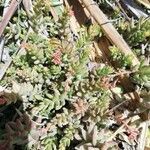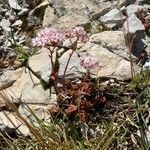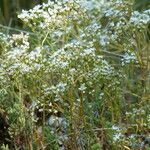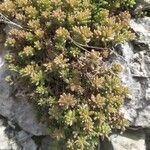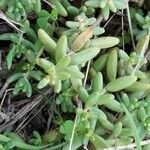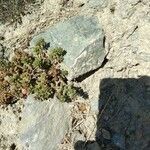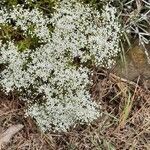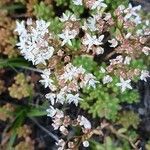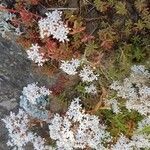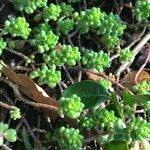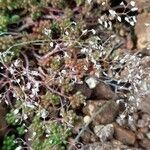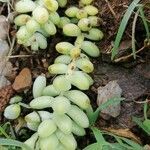Almost prostrate, mat-forming, perennial herb with slender stems rooting freely at nodes and shortly ascending in distal part, minutely glandular-hairy when young. Lvs alternate, sessile, confined to erect part of stem, dense and loosely imbricate but not forming terminal rosettes, 3-6-(17) × 2-4 mm, 1-3 mm thick, broadly ellipsoid, ellipsoid-obovoid or oblong, subterete and slightly flattened on upper side, entire, glabrous, dark green, brownish green, reddish green or glaucescent; apex rounded. Infl. terminal, 5-15 cm high, a flattened or corymbose, rather dense, glabrous cyme 2-5 × 3-6 cm; bracts very small and not leaflike, often caducous. Fls numerous, with pedicels 1-2 mm long, not secund. Sepals equal, c. 1.5 mm long, broadly elliptic. Petals 5, patent, 3-4 × 1.2-1.7 mm, lanceolate or elliptic-lanceolate, white, sharply acute. Stamens c. 3 mm long; filaments white; anthers purple. Carpels and styles white, ageing pink. Scales ± semi-lunate or very broadly spathulate. Follicles pinkish or streaked with red, ± parallel. Seed 0.8-1 mm long, ± narrowly ellipsoid, longitudinally ribbed.
Fibrous-rooted perennial from creeping stems, forming mats with more erect flowering stems 1–2 dm; lvs alternate, subterete, 0.6–1.5 cm, obtuse, scarcely spurred at base; infl convex, rather dense, repeatedly branched; fls mostly 5-merous; pet white, 3–4 mm; frs pink, erect; 2n=68, 136. Native of Eurasia, sometimes escaped from cult. June, July.
A small succulent plant. It grows 5-10 cm high and spreads 20-50 cm wide. It spreads and forms mats. It keeps growing from year to year. The leaves are 6-18 mm long. They are narrow and cylinder shaped and often have a red tint. The flowers are small and white and in heads.
